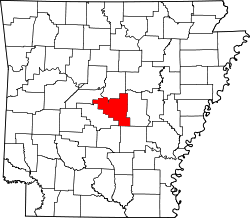Maumelle, Arkansas | |
|---|---|
 Location of Maumelle in Pulaski County, Arkansas. | |
| Coordinates: 34°51′08″N92°22′26″W / 34.85222°N 92.37389°W | |
| Country | United States |
| State | Arkansas |
| County | Pulaski |
| Founded | 1974 |
| Incorporated | 1985 |
| Area | |
• Total | 13.32 sq mi (34.49 km2) |
| • Land | 12.08 sq mi (31.28 km2) |
| • Water | 1.24 sq mi (3.22 km2) |
| Elevation | 266 ft (81 m) |
| Population (2020) | |
• Total | 19,251 |
• Estimate (2024) | 19,541 |
| • Density | 1,594.15/sq mi (615.50/km2) |
| Time zone | UTC-6 (CST) |
| • Summer (DST) | UTC-5 (CDT) |
| ZIP codes | 72113, 72118 |
| Area code | 501 |
| FIPS code | 05-44600 |
| GNIS feature ID | 2405039 [2] |
| Website | www |
Maumelle is a city in Pulaski County, Arkansas, United States. As of the 2020 census, the city's population was 19,251. The city is located northwest of Little Rock, bordering the opposite shore of the Arkansas River and is part of the Little Rock metropolitan area.



